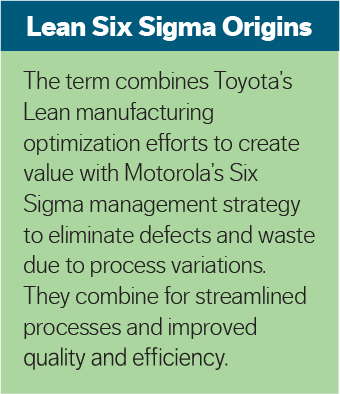
Providing consistent, quality care is essential for all hospitals, but patient care is hands-on. Variances in processes, even if small, can have profound ramifications. North Kansas City Hospital has launched Lean Six Sigma, a methodology using statistical analysis to improve processes. NKCH recently started with five projects and already has seen quantifiable outcomes in patient communication, efficiency and safety.
“We’re listening to our patients, physicians and staff, and we’re training people so we can build this skill set around improvement, structure and systematic processes across North Kansas City Hospital and Meritas Health,” said Monica Stone, MS, MBA, RN, vice president of Quality and Care Optimization.
Beyond what she calls a “plan, do, study, act” approach, Stone said Lean Six Sigma employs a methodology defined by the five steps of DMAIC:

Monica Stone, MS, MBA, RN
- Define: What is important?
- Measure: How are we doing?
- Analyze: What is wrong?
- Improve: What needs
- to be done?
- Control: How do we guarantee performance?
Villanova University reports the strategy, which has roots in the manufacturing and production industries, has been shown to improve patient care by:
- Reducing the number of errors made by physicians, nurses and technicians
- Improving lab turnaround times
- Reducing appointment wait times
- Decreasing steps in the supply chain
- Accelerating reimbursement for insurance claims
- Improving patient outcomes
Training
Vice presidents and senior directors selected 20 employees to participate in Lean Six Sigma teams, where they gained Green Belt certification in a four-month program. They learned methods for employing strategies and tools to further process improvement through team meetings, independent study and facilitated sessions with a Master Black Belt. The belts signify the levels in which they are qualified to complete projects and promote quality management practices.
Participants represented a cross section of NKCH and MH – an administrative assistant, a physician, NKCH and MH nurses, and staff from Environmental Services, Facilities, and Food and Nutrition Services.
“In their final presentations, they walked through all of the DMAIC steps, including what they found to be the problem, what they measured, what they analyzed to be contributing factors, what could be improved, and what solutions they attempted to put in place,” said Stone, who has Green Belt certification.
Results
The five teams shared these results:
- Discharge throughput: Reduced inpatient ECHO order to patient discharge by 29% or 109 minutes
- Patient identification: Decreased error rate on blood tube labels (e.g., smudged ink, incorrect name) in Critical Care from 2.5 instances to 0.66 instances per month.
- Stroke dysphagia screening: Improved start of screening process from 82% to 98% screened
- ICU bed turnaround: Reduced turnaround time from 45 to 26 minutes
- Post-discharge communication: Increased patient follow-up completion percentage from 42% to 95%
They shared these results with the operations group, which provided feedback. “Now that these team members possess these skills, they will lead their own staff in making improvements when problems are identified,” Stone said.
“And now we’re taking applications for the next set of teams with different focus areas. We already have a number of people applying, which is exciting.”